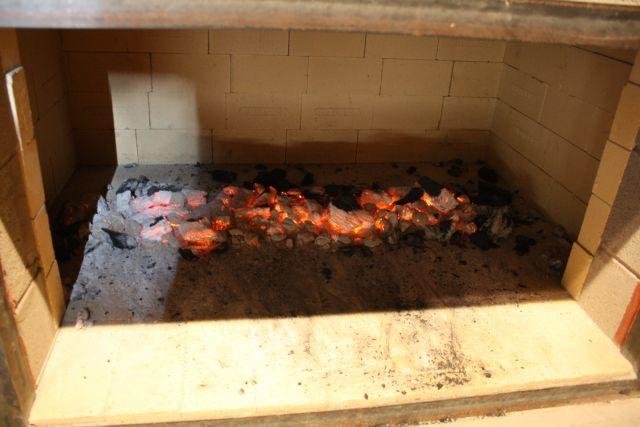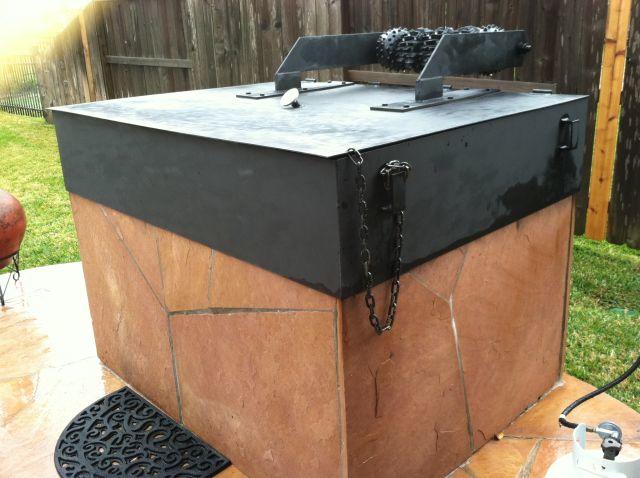After 18 months of construction (on and off), my indoor concrete block pit is complete. I have many pictures that were taken during the construction. Final pictures only are shown for now. Some stats: it's OD is 4ft x 6 ft and it is 42 inches tall. The cooking grate is 56 x 32 inches. The interior is lined with fire brick up to the bottom of the cooking grate. A design decision was to vent it to the outside via a chimney. If I was to do it again, I would likely just let the smoke fill the room and use a ceiling mounted exhaust fan to vent the smoke. The decision to vent through the roof was an expensive decision. The design is unproven, however I can independently control air intake through the vents in the door and the flue via a damper and grates inside the smoker. The vent construction is an overkill in terms of flue size but was driven by the local code inspector.
The plan was to have an outside fireplace and an inside pit. Hickory wood was to be burned in the fireplace to create the fuel for the pit as is the Western Kentucky tradition. However, I have spent greater than $2000 on the pit and it is winter so the fireplace will have to wait on the spring and more cash. The local city fire marshal will not allow me to build a outside fireplace despite the fact that several neighbors have them. Texas is in a severe drought state and it is now the local ordinance. However, I can build the fireplace inside the storage building and so that is the current plan. But for now, I have to use lump charcoal.
I have made two runs cooking four pork shoulders in each run. I use about 30 pounds of lump charcoal per run. The pit retains heat nicely and the heat is fairly constant needing to add some charcoal every two hours or so. The meat was tender and done after 16 hours or so each run. The internal temperature of one shoulder that I probed was 177F when done to tender. Cooking temperature was maintained between 190F and 200F. This is lower that what I have been used to with my GOSM propane smoker but is where I was advised to cook by friends who also have concrete block smokers.
Here is where I need some help. While the meat is tender and moist, it has very little smoke flavor. The meat, after 16 hours, has little color. It is not dark and smoky as I get when using my GOSM propane smoker and also compared to Western KY shoulders when purchased from a BBQ place. So it would be obvious that I am not getting enough smoke. The first run, I had the flue damper in 25% open. So after ending the run and not having enough smoke flavor, I theorized that the vent to the outside was too efficient and all the smoke was going up the flue. So, on the second run, I added damper registers to the intakes and completely closed off the vents and flue damper. The room filled with smoke more and it certainly seemed like there was enough smoke. There was no improvement in smoke flavor of the meat however. My design of using a flue to the outside assumed that in order to keep my coals from going out, that I would need a flow of air in the front and out the top of the smoker. This is certainly consistent with most smoker designs. However, I did not have any issues with the coals extinguishing without the flue on the second run. It appears that the coals get enough oxygen from the louvers in the doors.
Is it that the lump charcoal (B&B Oak lump charcoal) produces little smoke after being lit? Would the wood burnt in the fireplace give off more smoke when the coals are shoveled into the pit? Is there a design issue with the pit? There is 30 inches from the fire to the cooking grate by design. This was intentional as I was advised to keep enough distance from the coals and the meat so as to not cook too hot. Indeed, the temperature is easily maintained. It would seem that the smoke would pool near the top of the cooker no matter the distance anyway.
Any Ideas?
Last edited:















